如何在scrapy框架下用python爬取json文件
Posted
tags:
篇首语:本文由小常识网(cha138.com)小编为大家整理,主要介绍了如何在scrapy框架下用python爬取json文件相关的知识,希望对你有一定的参考价值。
生成Request的时候与一般的网页是相同的,提交Request后scrapy就会下载相应的网页生成Response,这时只用解析response.body按照解析json的方法就可以提取数据了。代码示例如下(以京东为例,其中的parse_phone_price和parse_commnets是通过json提取的,省略部分代码):# -*- coding: utf-8 -*-
from scrapy.spiders import Spider, CrawlSpider, Rule
from scrapy.linkextractors import LinkExtractor
from jdcom.items import JdPhoneCommentItem, JdPhoneItem
from scrapy import Request
from datetime import datetime
import json
import logging
import re
logger = logging.getLogger(__name__)
class JdPhoneSpider(CrawlSpider):
name = "jdPhoneSpider"
start_urls = ["http://list.jd.com/list.html?cat=9987,653,655"]
rules = (
Rule(
LinkExtractor(allow=r"list\\.html\\?cat\\=9987,653,655\\&page\\=\\d+\\&trans\\=1\\&JL\\=6_0_0"),
callback="parse_phone_url",
follow=True,
),
)
def parse_phone_url(self, response):
hrefs = response.xpath("//div[@id=\'plist\']/ul/li/div/div[@class=\'p-name\']/a/@href").extract()
phoneIDs = []
for href in hrefs:
phoneID = href[14:-5]
phoneIDs.append(phoneID)
commentsUrl = "http://sclub.jd.com/productpage/p-%s-s-0-t-3-p-0.html" % phoneID
yield Request(commentsUrl, callback=self.parse_commnets)
def parse_phone_price(self, response):
phoneID = response.meta[\'phoneID\']
meta = response.meta
priceStr = response.body.decode("gbk", "ignore")
priceJson = json.loads(priceStr)
price = float(priceJson[0]["p"])
meta[\'price\'] = price
phoneUrl = "http://item.jd.com/%s.html" % phoneID
yield Request(phoneUrl, callback=self.parse_phone_info, meta=meta)
def parse_phone_info(self, response):
pass
def parse_commnets(self, response):
commentsItem = JdPhoneCommentItem()
commentsStr = response.body.decode("gbk", "ignore")
commentsJson = json.loads(commentsStr)
comments = commentsJson[\'comments\']
for comment in comments:
commentsItem[\'commentId\'] = comment[\'id\']
commentsItem[\'guid\'] = comment[\'guid\']
commentsItem[\'content\'] = comment[\'content\']
commentsItem[\'referenceId\'] = comment[\'referenceId\']
# 2016-09-19 13:52:49 %Y-%m-%d %H:%M:%S
datetime.strptime(comment[\'referenceTime\'], "%Y-%m-%d %H:%M:%S")
commentsItem[\'referenceTime\'] = datetime.strptime(comment[\'referenceTime\'], "%Y-%m-%d %H:%M:%S")
commentsItem[\'referenceName\'] = comment[\'referenceName\']
commentsItem[\'userProvince\'] = comment[\'userProvince\']
# commentsItem[\'userRegisterTime\'] = datetime.strptime(comment[\'userRegisterTime\'], "%Y-%m-%d %H:%M:%S")
commentsItem[\'userRegisterTime\'] = comment.get(\'userRegisterTime\')
commentsItem[\'nickname\'] = comment[\'nickname\']
commentsItem[\'userLevelName\'] = comment[\'userLevelName\']
commentsItem[\'userClientShow\'] = comment[\'userClientShow\']
commentsItem[\'productColor\'] = comment[\'productColor\']
# commentsItem[\'productSize\'] = comment[\'productSize\']
commentsItem[\'productSize\'] = comment.get("productSize")
commentsItem[\'afterDays\'] = int(comment[\'days\'])
images = comment.get("images")
images_urls = ""
if images:
for image in images:
images_urls = image["imgUrl"] + ";"
commentsItem[\'imagesUrl\'] = images_urls
yield commentsItem
commentCount = commentsJson["productCommentSummary"]["commentCount"]
goodCommentsCount = commentsJson["productCommentSummary"]["goodCount"]
goodCommentsRate = commentsJson["productCommentSummary"]["goodRate"]
generalCommentsCount = commentsJson["productCommentSummary"]["generalCount"]
generalCommentsRate = commentsJson["productCommentSummary"]["generalRate"]
poorCommentsCount = commentsJson["productCommentSummary"]["poorCount"]
poorCommentsRate = commentsJson["productCommentSummary"]["poorRate"]
phoneID = commentsJson["productCommentSummary"]["productId"]
priceUrl = "http://p.3.cn/prices/mgets?skuIds=J_%s" % phoneID
meta =
"phoneID": phoneID,
"commentCount": commentCount,
"goodCommentsCount": goodCommentsCount,
"goodCommentsRate": goodCommentsRate,
"generalCommentsCount": generalCommentsCount,
"generalCommentsRate": generalCommentsRate,
"poorCommentsCount": poorCommentsCount,
"poorCommentsRate": poorCommentsRate,
yield Request(priceUrl, callback=self.parse_phone_price, meta=meta)
pageNum = commentCount / 10 + 1
for i in range(pageNum):
commentsUrl = "http://sclub.jd.com/productpage/p-%s-s-0-t-3-p-%d.html" % (phoneID, i)
yield Request(commentsUrl, callback=self.parse_commnets) 参考技术A import json
str = str[(str.find('(')+1):str.rfind(')')] #去掉首尾的圆括号前后部分
dict = json.loads(str)
comments = dict['comments']
#然后for一下就行了
基于python的scrapy框架爬取豆瓣电影及其可视化
1.Scrapy框架介绍
主要介绍,spiders,engine,scheduler,downloader,Item pipeline
scrapy常见命令如下:

对应在scrapy文件中有,自己增加爬虫文件,系统生成items,pipelines,setting的配置文件就这些。
items写需要爬取的属性名,pipelines写一些数据流操作,写入文件,还是导入数据库中。主要爬虫文件写domain,属性名的xpath,在每页添加属性对应的信息等。
movieRank = scrapy.Field() movieName = scrapy.Field() Director = scrapy.Field() movieDesc = scrapy.Field() movieRate = scrapy.Field() peopleCount = scrapy.Field() movieDate = scrapy.Field() movieCountry = scrapy.Field() movieCategory = scrapy.Field() moviePost = scrapy.Field()
import json class DoubanPipeline(object): def __init__(self): self.f = open("douban.json","w",encoding=‘utf-8‘) def process_item(self, item, spider): content = json.dumps(dict(item),ensure_ascii = False)+" " self.f.write(content) return item def close_spider(self,spider): self.f.close()
这里xpath使用过程中,安利一个chrome插件xpathHelper。
allowed_domains = [‘douban.com‘] baseURL = "https://movie.douban.com/top250?start=" offset = 0 start_urls = [baseURL + str(offset)] def parse(self, response): node_list = response.xpath("//div[@class=‘item‘]") for node in node_list: item = DoubanItem() item[‘movieName‘] = node.xpath("./div[@class=‘info‘]/div[1]/a/span/text()").extract()[0] item[‘movieRank‘] = node.xpath("./div[@class=‘pic‘]/em/text()").extract()[0] item[‘Director‘] = node.xpath("./div[@class=‘info‘]/div[@class=‘bd‘]/p[1]/text()[1]").extract()[0] if len(node.xpath("./div[@class=‘info‘]/div[@class=‘bd‘]/p[@class=‘quote‘]/span[@class=‘inq‘]/text()")): item[‘movieDesc‘] = node.xpath("./div[@class=‘info‘]/div[@class=‘bd‘]/p[@class=‘quote‘]/span[@class=‘inq‘]/text()").extract()[0] else: item[‘movieDesc‘] = "" item[‘movieRate‘] = node.xpath("./div[@class=‘info‘]/div[@class=‘bd‘]/div[@class=‘star‘]/span[@class=‘rating_num‘]/text()").extract()[0] item[‘peopleCount‘] = node.xpath("./div[@class=‘info‘]/div[@class=‘bd‘]/div[@class=‘star‘]/span[4]/text()").extract()[0] item[‘movieDate‘] = node.xpath("./div[2]/div[2]/p[1]/text()[2]").extract()[0].lstrip().split(‘xa0/xa0‘)[0] item[‘movieCountry‘] = node.xpath("./div[2]/div[2]/p[1]/text()[2]").extract()[0].lstrip().split(‘xa0/xa0‘)[1] item[‘movieCategory‘] = node.xpath("./div[2]/div[2]/p[1]/text()[2]").extract()[0].lstrip().split(‘xa0/xa0‘)[2] item[‘moviePost‘] = node.xpath("./div[@class=‘pic‘]/a/img/@src").extract()[0] yield item if self.offset <250: self.offset += 25 url = self.baseURL+str(self.offset) yield scrapy.Request(url,callback = self.parse)
这里基本可以爬虫,产生需要的json文件。
接下来是可视化过程。
我们先梳理一下,我们掌握的数据情况。
douban = pd.read_json(‘douban.json‘,lines=True,encoding=‘utf-8‘) douban.info()
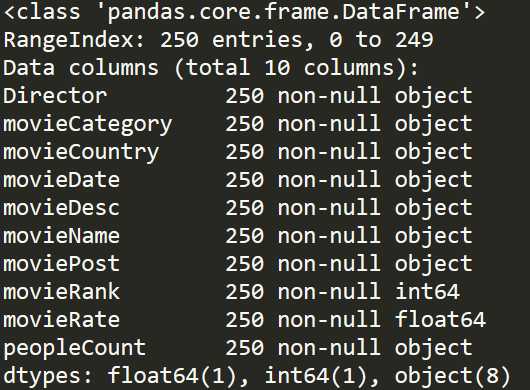
基本我们可以分析,电影国家产地,电影拍摄年份,电影类别以及一些导演在TOP250中影响力。
先做个简单了解,可以使用value_counts()函数。
douban = pd.read_json(‘douban.json‘,lines=True,encoding=‘utf-8‘) df_Country = douban[‘movieCountry‘].copy() for i in range(len(df_Country)): item = df_Country.iloc[i].strip() df_Country.iloc[i] = item[0] print(df_Country.value_counts())
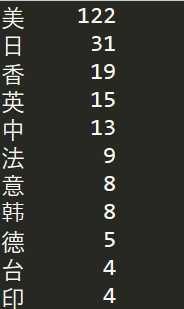
美国电影占半壁江山,122/250,可以反映好莱坞电影工业之强大。同样,日本电影和香港电影在中国也有着重要地位。令人意外是,中国大陆地区电影数量不是令人满意。豆瓣影迷对于国内电影还是非常挑剔的。
douban = pd.read_json(‘douban.json‘,lines=True,encoding=‘utf-8‘) df_Date = douban[‘movieDate‘].copy() for i in range(len(df_Date)): item = df_Date.iloc[i].strip() df_Date.iloc[i] = item[2] print(df_Date.value_counts())
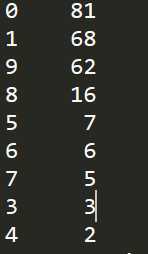
2000年以来电影数目在70%以上,考虑10代才过去9年和打分滞后性,总体来说越新的电影越能得到受众喜爱。这可能和豆瓣top250选取机制有关,必须人数在一定数量以上。
douban = pd.read_json(‘douban.json‘,lines=True,encoding=‘utf-8‘) df_Cate = douban[‘movieCategory‘].copy() for i in range(len(df_Cate)): item = df_Cate.iloc[i].strip() df_Cate.iloc[i] = item[0] print(df_Cate.value_counts())
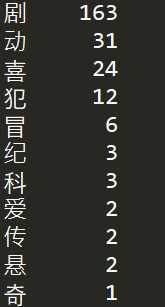
剧情电影情节起伏更容易得到观众认可。
下面展示几张可视化图片
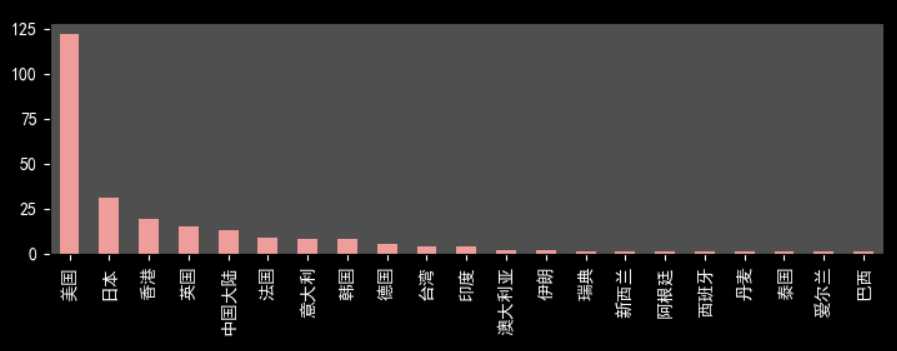

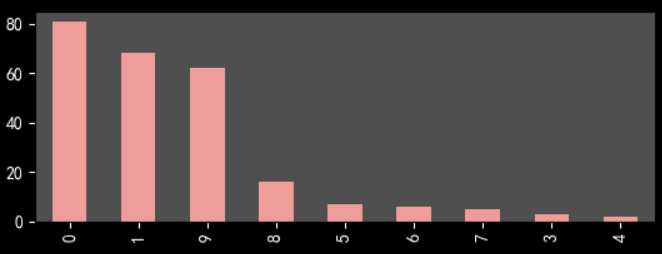
不太会用python进行展示,有些难看。其实,推荐用Echarts等插件,或者用Excel,BI软件来处理图片,比较方便和美观。
第一次做这种爬虫和可视化,多有不足之处,恳请指出。
以上是关于如何在scrapy框架下用python爬取json文件的主要内容,如果未能解决你的问题,请参考以下文章